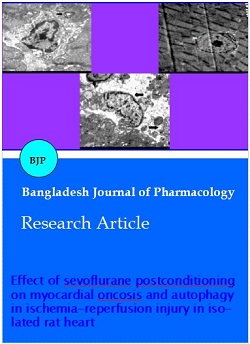Effect of sevoflurane postconditioning on myocardial oncosis and autophagy in ischemia-reperfusion injury in isolated rat heart
DOI:
https://doi.org/10.3329/bjp.v13i3.36437Keywords:
Heart, Ischemia-reperfusion, Myocardial oncosis, SevofluraneAbstract
The effects of sevoflurane postconditioning on myocardial oncosis and autophagy were studied in 32 isolated rat heart of ischemia-reperfusion injury. The hearts were perfused by: a) Sham surgery group, b) simple sevoflurane group, c) simple ischemia-reperfusion group (I/R) group, and d) sevoflurane postconditioning group. The ratios between the gray density values of the target bands to the gray density value of GADPH were used to reflect the Beclin-1, LC3II/I, and porimin expression levels. The LC3II/I level in the sevoflurane postconditioning group was lower than the level in the I/R group. The porimin level in the sevoflurane postconditioning group was lower than the level in the I/R group. The myocardial infarction range in the sevoflurane postconditioning group (33 ± 5%) was significantly diminished compared with the range in the I/R group (53 ± 6%) (p<0.05). Sevoflurane decreased the occurrence of oncosis and alleviated myocardial ischemia-reperfusion injury by inhibiting MPTP opening.
Video Clip of Methodology:
14 min 31 sec Click to watch
Downloads
108
138 Read
21

Published
How to Cite
Issue
Section
License
Authors who publish with this journal agree to the following terms:
- Authors retain copyright and grant the journal right of first publication with the work simultaneously licensed under a Creative Commons Attribution License that allows others to share the work with an acknowledgement of the work's authorship and initial publication in this journal.
- Authors are able to enter into separate, additional contractual arrangements for the non-exclusive distribution of the journal's published version of the work (e.g., post it to an institutional repository or publish it in a book), with an acknowledgement of its initial publication in this journal.
- Authors are permitted and encouraged to post their work online (e.g., in institutional repositories or on their website) prior to and during the submission process, as it can lead to productive exchanges, as well as earlier and greater citation of published work (See The Effect of Open Access).
